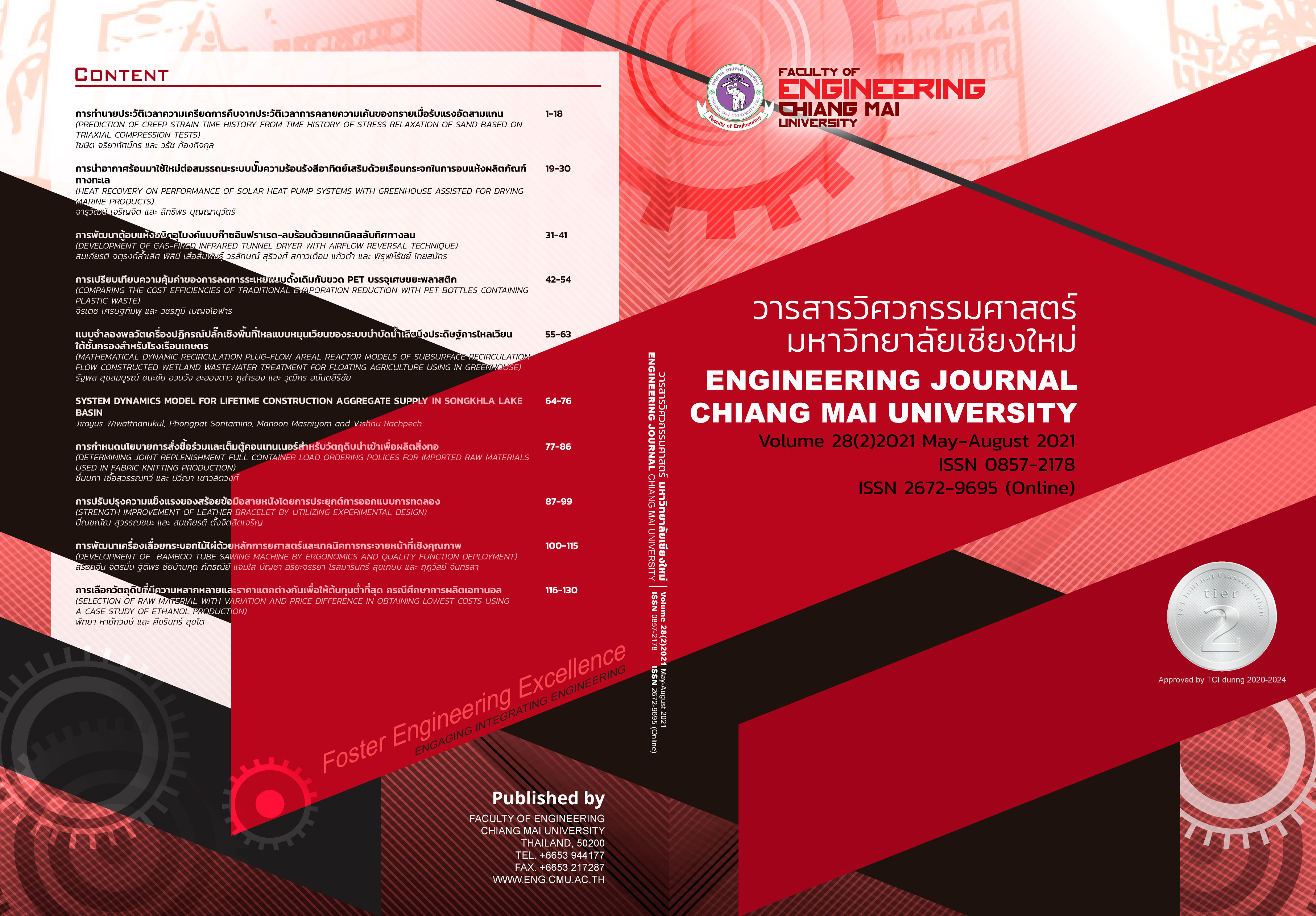การทำนายประวัติเวลาความเครียดการคืบจากประวัติเวลาการคลายความเค้นของทรายเมื่อรับแรงอัดสามแกน
คำสำคัญ:
การคืบ, การคลายความเค้น, การทดสอบแรงอัดสามแกน, ทราย, อัตราความเครียดบทคัดย่อ
วัสดุทางวิศวกรรมเทคนิคธรณีจะแสดงพฤติกรรมตอบสนองต่ออิทธิพลจากอัตราการให้แรงกระทำเนื่องจากสมบัติความหนืดของวัสดุ เช่น การคืบเมื่อให้แรงกระทำคงค้าง การคลายความเค้นเมื่อควบคุมความเครียดให้คงที่ ความเค้นกระโดดเมื่อเปลี่ยนอัตราความเครียดอย่างทันทีทันใด เป็นต้น การทำนายความเครียดการคืบที่แม่นยำมีความสำคัญต่อการประเมินสมรรถนะของโครงสร้างดินเมื่อรับแรงกระทำใช้งานในระยะยาว งานวิจัยนี้ได้ทำการทดสอบแรงอัดสามแกนกับตัวอย่างทราย KMUTT ด้วยประวัติการให้แรงแบบต่าง ๆ เพื่อศึกษาชนิดความหนืดและพฤติกรรมการคืบและการคลายความเค้นที่อัตราส่วนความเค้นต่าง ๆ เพื่อสร้างโครงสร้างการวิเคราะห์ซึ่งพัฒนาจากความสัมพันธ์ระหว่างเวลาการคืบกับเวลาการคลายความเค้น และความสัมพันธ์ระหว่างความเครียดไม่คืนกลับการคืบกับความเครียดไม่คืนกลับการคลายความเค้น ที่อัตราความเครียดไม่คืนกลับเท่ากัน จากผลการศึกษาพบว่า 1. ทราย KMUTT แสดงพฤติกรรมตอบสนองต่ออิทธิพลจากอัตราการให้แรงกระทำโดยมีชนิดความหนืดแบบ TESRA ซึ่งในช่วงก่อนจุดสูงสุดและแปลงไปเป็นแบบ P&N ในช่วงหลังจุดสูงสุด 2. ประวัติเวลาความเครียดการคืบสามารถทำนายได้อย่างแม่นยำจากประวัติเวลาการคลายความเค้นที่มีระยะเวลาสั้นกว่ามาก และ 3. แฟกเตอร์เวลาที่ทำนายได้มีค่าเพิ่มขึ้นกับอัตราส่วนความเค้น
References
Tatsuoka, F., (2007), Inelastic Deformation Characteristics of Geomaterial, Soil Stress-Strain Behavior: Measurement, Modeling and Analysis, March 2007, pp 1-108.
Tatsuoka, F., Di Benedetto, H., Enomoto, T., Kawabe, S. and Kongkitkul, W., (2008), Various Viscosity Types of Geomaterials in Shear and Their Mathematical Expression, Soils and Foundations, Vol. 48(1), pp. 41-60.
Duttine, A., Tatsuoka, F., Salotti, A. and Ezaoui, A., (2015), Creep and Stress Relaxation Envelopes of Granular Materials in Direct Shear. paper presented in Proc. of 15th Pan-American Conference on Soil Mechanics and Geotechnical Engineering and 6th International Conference on Deformation Characteristics of Geomaterials, Buenos Aires.
Jardine, R.J., Standing, J.R. and Kovacevic, N., (2005), Lessons Learned from Full Scale Observations and the Practical Application of Advanced Testing and Modelling. Proceedings of the 3rd International Symposium on Deformation Characteristics of Geomaterials, Lyon, France, Vol. 2, pp. 201-245.
Furudoi, T. and Kobayashi, M., (2009), Geotechnical Issues and Approach on Kansai International Airport Project—Prediction and Performance of Settlement, J. Soc. Civ. Eng. Ser. C, Vol. 65(4), pp. 998-1017.
Lade, P. and Karimpour, H., (2010), Static Fatigue Controls Particle Crushing And, Soils and Foundations, Vol. 50, pp. 573-583.
Nuntapanich, N., Kongkitkul, W., Tatsuoka, F. and Jongpradist, P., (2018), Prediction of Creep Behaviour from Load Relaxation Behaviour of Polymer Geogrids, Geosynthetics International, Vol. 25(3), pp. 334-349.
Tatsuoka, F. and Haibara, O., (1985), Shear Resistance between Sand and Smooth or Lubricated Surfaces, Soils and Foundations, Vol. 25(1), pp. 89-98.
Santucci de Magistris, F., Koseki, J., Amaya, M., Hamaya, S., Sato, T. and Tatsuoka, F., (1999), A Triaxial Testing System to Evaluate Stress-Strain Behavior of Soils for Wide Range of Strain and Strain Rate, Geotechnical Testing Journal, Vol. 22(1), pp.44-60.
Kongkitkul, W., Hirakawa, D. and Tatsuoka, F., (2007), Viscous Behaviour of Geogrids; Experiment and Simulation, Soils and Foundations, Vol. 47(2), pp. 265-283.
Downloads
เผยแพร่แล้ว
ฉบับ
บท
License
ลิขสิทธิ์ของบทความที่ตีพิมพ์ในวารสารฉบับนี้จะยังเป็นของผู้แต่งและยินยอมให้สิทธิ์เผยแพร่กับทางวารสาร
การเผยแพร่ในระบบวารสารแบบเปิดนี้ บทความจะสามารถนำไปใช้ได้ฟรีในการศึกษา และในทางที่ไม่เกี่ยวกับการค้า



